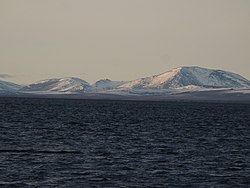Geography
According to the U.S. Census Bureau, the borough has a total area of 40,749 square miles (105,540 km2), of which 35,573 square miles (92,130 km2) is land and 5,176 square miles (13,410 km2) (12.7%) is water. [6] By land area, it is slightly larger than the state of Maine.
Its coastline is limited by the Chukchi Sea. The Kotzebue Sound, a significant wildlife area, is a prominent water body within the Northwest Arctic Borough. The largest polar bear sighted in history, a male weighing 2,209 pounds (1,002 kg), was sighted at Kotzebue Sound. [7]
Adjacent boroughs and census areas
Demographics
Historical population| Census | Pop. | Note | %± |
|---|
| 1960 | 3,560 | | — |
|---|
| 1970 | 4,434 | | 24.6% |
|---|
| 1980 | 4,831 | | 9.0% |
|---|
| 1990 | 6,113 | | 26.5% |
|---|
| 2000 | 7,208 | | 17.9% |
|---|
| 2010 | 7,523 | | 4.4% |
|---|
| 2020 | 7,793 | | 3.6% |
|---|
| 2024 (est.) | 7,134 | [9] | −8.5% |
|---|
|
At the 2000 census, [14] there were 7,208 people, 1,780 households and 1,404 families residing in the borough. The population density was 0.18 per square mile (0.069/km2). There were 2,540 housing units at an average density of 0 per square mile (0/km2). The racial makeup of the borough was 12.32% White, 0.21% Black or African American, 82.46% Native American, 0.89% Asian, 0.06% Pacific Islander, 0.36% from other races, and 3.70% from two or more races. 0.79% of the population were Hispanic or Latino of any race. 40.00% reported speaking Inupiat or "Eskimo" at home. [15]
There were 1,780 households, of which 55.20% had children under the age of 18 living with them, 47.90% were married couples living together, 19.70% had a female householder with no husband present, and 21.10% were non-families. 16.60% of all households were made up of individuals, and 2.10% had someone living alone who was 65 years of age or older. The average household size was 3.87 and the average family size was 4.36. [4]
Age distribution was 41.50% under the age of 18, 10.00% from 18 to 24, 28.10% from 25 to 44, 15.50% from 45 to 64, and 5.00% who were 65 years of age or older. The median age was 24 years. For every 100 females, there were 114.50 males. For every 100 females age 18 and over, there were 120.70 males. [4]
2020 Census
Northwest Arctic Borough, Alaska – Racial composition| Race (NH = Non-Hispanic) | 2020 [16] | 2010 [17] | 2000 [18] | 1990 [19] | 1980 [20] |
|---|
| White alone (NH) | 8.8%
(684) | 11%
(830) | 12.2%
(878) | 13.5%
(824) | 14%
(677) |
| Black alone (NH) | 0.9%
(71) | 0.5%
(35) | 0.2%
(15) | 0.2%
(12) | 0.1%
(5) |
| American Indian alone (NH) | 82.8%
(6,453) | 81.1%
(6,102) | 82.1%
(5,919) | 84.9%
(5,190) | 85%
(4,108) |
| Asian alone (NH) | 0.7%
(53) | 0.6%
(42) | 0.9%
(64) | 0.8%
(48) | 0.1%
(4) |
| Pacific Islander alone (NH) | 0.1%
(11) | 0.2%
(12) | 0.1%
(4) |
| Other race alone (NH) | 0%
(0) | 0%
(3) | 0.1%
(8) | 0%
(3) | 0.1%
(6) |
| Multiracial (NH) | 5.4%
(419) | 5.9%
(441) | 3.6%
(263) | — | — |
| Hispanic/Latino (any race) | 1.3%
(102) | 0.8%
(58) | 0.8%
(57) | 0.6%
(36) | 0.6%
(31) |
The most reported detailed ancestries were: [21]
This page is based on this
Wikipedia article Text is available under the
CC BY-SA 4.0 license; additional terms may apply.
Images, videos and audio are available under their respective licenses.





